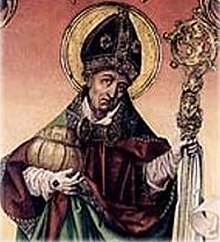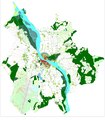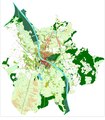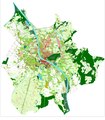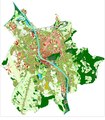History of the city of Salzburg
The history of the city of Salzburg begins as early as the Neolithic Age with the first settlement of today's city area around the Salzach. The city of Salzburg has a particularly long cultural tradition. With the explicit mention of an archbishop's city judge (first documented in 1120/1130), Salzburg is the oldest city in what is now Austria. Here you can find the oldest road tunnel in Austria, the Sigmundstor , the oldest medieval water tunnel in Central Europe and the Stiftsarm tunnel of the Alm Canal . The world's oldest preserved funicular railway, the tearing train to the Hohensalzburg Fortress and probably the oldest preserved manorial avenue in Europe, Hellbrunner Allee, are also located in the city area. The world's oldest dwarf garden is also located in Salzburg as part of the Mirabell Gardens .
Early history
The area of the city of Salzburg around today's Rainberg , Festungsberg, Kapuzinerberg, Hellbrunnerberg has been settled since the Neolithic Age. Small settlement centers also existed on Kleßheimer Allee and in Liefering-Rott . In Celtic times there were also settlements on Bürglstein, in Parsch, Gnigl and Maxglan. These settlements ultimately formed an important administrative center for the Celtic alums.
Roman times
The population on the city mountains was reduced after the Roman invasion in 15 BC. Moved into the area of the old town, which was rebuilt under the name Iuvavum . The name Iuvavum is not derived from a Roman deity, but is likely to be of Celtic origin (Iuvavo). The city developed primarily on the left bank of the Salzach, where the Salzach and Mönchsberg offered natural protection; strong fortifications were only necessary to the south. 45 n. Chr the city. Received by Emperor Claudius the Munizipalrecht and then was called Municipium Claudium Juvavum . Salzburg was one of the most important cities of the new Roman province of Noricum and in late Roman times it was on the way to Germania from “Ufernoricum” . 171 Marcomanni and Quads largely destroyed the city, which was then largely rebuilt under Septimius Severus (193-211). In 241 the Alemanni devastated the city again. Under Diocletian and under Constantine the Great (306–337) Iuvavum experienced a last heyday. In 488, with the abandonment of the province of Noricum, a large part of the Romano-Celtic population left the city of Salzburg on Odoacer's orders. As a result, the rest of the residents withdrew to the Nonnberg and the Festungsberg, perhaps also to Rainberg and Kapuzinerberg.
Salzburg as a Bavarian city
Early middle ages
There is evidence of a monastery from the 5th century AD, which presumably survived the migration of the peoples. In 696, Bishop Rupert received the remains of the old Roman city from Duke Theodo II of Bavaria in order to evangelize the country in the east and south-east. He founded or renewed the monastery of St. Peter and founded the Benedictine women's monastery in Nonnberg . The name Salzburg can be traced for the first time in 755. Salzburg's bishopric was completed in 739 and Salzburg's first cathedral was completed in 774. On April 20, 798 Salzburg was by Pope Leo III. elevated to an archbishopric at the request of the Frankish king Charlemagne . As a church province, it encompassed almost the entire old Bavarian tribal area. This included Lower Bavaria, Upper Bavaria, Upper Palatinate and a large part of today's Austria.
High Middle Ages
During investiture disputes between the emperor and the pope in the 11th and 12th centuries, the archbishop and thus also the city and state of Salzburg were largely on the side of the pope. The archbishop, who was still appointed by the emperor at that time, was obliged to the pope and the emperor. Archbishop Gebhard also confessed to Pope Gregory VII , despite his previous office as Chancellor, and subsequently to the anti-king Rudolf of Swabia . He was therefore expelled by Henry IV for infidelity.
Friedrich Barbarossa imposed the imperial ban on Salzburg in 1166, as Archbishop Konrad II of Babenberg came to rule Salzburg without the imperial enfeoffment and also Pope Alexander III. and did not support the imperial antipope. In 1168 the loyal Counts of Plain burned the city down as punishment on behalf of the emperor. The cathedral and six churches were also destroyed. Conrad III. von Wittelsbach and his successor rebuilt the cathedral after 1181 (Konradinischer Dom). This new cathedral had five towers, was larger than today's cathedral and was one of the largest and most important churches north of the Alps.
Archbishop Eberhard II succeeded with prudence and diplomacy between 1200 and 1246 in building a closed archiepiscopal territory from counties, courts and bailiwicks within Bavaria. At that time the city and state of Salzburg experienced an economic and cultural heyday that had not been reached for three centuries. At that time a new city bridge was built (possibly the first city bridge), the first breweries settled in the city, the Franciscan church was rebuilt and the Chiemseehof was built as the residence of the bishops of Chiemsee. In 1275 Salzburg's western border ( Rupertigau ) to the Chiemgau was confirmed by the Landshut Duke Heinrich . As a result, Salzburg became more and more influential and broke away more and more from the motherland of Bavaria. At that time, the main source of income for the city and state of Salzburg, in addition to mining, was primarily the extraction and trade in salt from the Dürrnberg. The wealth of the royal seat was to be based on the "white gold" until the high baroque period.
Salzburg as the prince-archbishop's residence city
Late Middle Ages and Early Modern Times
Since the Battle of Mühldorf in 1322, in which Salzburg fought alongside the Habsburgs against Bavaria, the archbishopric had been enemies with the motherland of Bavaria. In 1328, the archbishop issued its own regional order in Salzburg. In the following decades it became a largely independent state within the Holy Roman Empire . In church terms, the Archbishop of Salzburg remained the head of the old Bavarian regional church until 1816. In 1348–1350, many Salzburg citizens were victims of a major plague epidemic. Regardless of this, the urban population grew rapidly as a result. 1481 granted Emperor Friedrich III. In the course of his disputes with Archbishop Bernhard von Rohr, the citizens of the city of Salzburg were given the right to freely elect the city council and mayor in a council letter. In 1511 Archbishop Leonhard von Keutschach ended the following year-long conflicts with the Salzburg citizens and the city councilors through cunning and violence: He captured mayors and councilors who had come unsuspecting to a banquet and forced them to renounce all city privileges.
During the German Peasants' War , there was also an uprising of the peasants and miners in Salzburg in 1525 . The rebels moved to Salzburg and were allowed into the city by the citizens as allies. Archbishop Matthäus Lang von Wellenburg and his entourage had to flee to the fortress, which was then besieged for three months without success. After the intervention of troops of the Swabian Federation, Duke Ludwig of Bavaria brokered an armistice in which the rebels were agreed to withdraw. The Salzburg peasant uprising of 1526 was limited to the Pongau and Pinzgau.
Salzburg in the baroque era
At the beginning of the 17th century, Archbishop Wolf Dietrich von Raitenau redesigned the city of Salzburg as an “ideal” and representative city, which gave today's old town of Salzburg its characteristic appearance. Vincenzo Scamozzi was appointed first as the master builder for a new building for the Salzburg Cathedral , which burned down for the eighth time in 1598 . Disputes with the Bavarians over salt and tariffs prompted Wolf Dietrich in 1611 to occupy the prince-provost of Berchtesgaden , which was directly under the empire . Bavaria then occupied Salzburg and ensured the election of Markus Sittikus as Wolf Dietrich's successor. After Wolf Dietrich's dismissal, the Swiss master Santino Solari was commissioned as the architect for the cathedral , who was able to complete today's smaller cathedral by 1628. The cathedral towers were not completed until 1655. Markus Sittikus 'successor, Paris von Lodron , succeeded in keeping Salzburg out of the Thirty Years' War through a clever and cautious policy of neutrality .
A grammar school was set up in 1617 as a preliminary to the university; earlier attempts had mostly failed due to a lack of space. In 1622 the grammar school became the University of Salzburg with a theological and philosophical faculty. This foundation was an essential part of the counter-reformation policy of the prince archbishops. Above all, it was intended to improve the formation of priests.
Just a few years after Luther posted his theses , the majority of the citizens of Salzburg were very open to Protestantism. The dissatisfaction of the citizens with the absolutely ruling Prince Archbishop Matthäus Lang von Wellenburg was added. The peasant wars of 1525 again revealed the sympathy of many craftsmen and citizens for Protestantism. The preacher Paul Speratus took an opportunity to preach in the Evangelical spirit in the Salzburg Franciscan Church. In the city of Salzburg, almost all Protestant families had to leave the country before 1590. Children under the age of 15, including babies, often had to be left behind and were raffled off among Catholic families. Archbishop Leopold Anton von Firmian finally issued the emigration patent together with his dogmatic court chancellor Christani di Rallo in 1731, which ordered the expulsion of another 20,000 Salzburg Protestants ( Salzburg exiles ). However, this expulsion affected almost no residents of the city of Salzburg, as there were almost no Protestants in the city at that time. From 1772 to 1803, during the reign of Archbishop Hieronymus Colloredo , Salzburg became the center of the Late Enlightenment . The school system was reformed according to the Austrian model and numerous scientists and artists were called to Salzburg.

Salzburg as a travel destination in the 18th century
According to the educator and publicist Lorenz Hübner , the traveler had to take at least four months to get to know the city of Salzburg and the surrounding area, even in good weather and dry roads. The reasons for this were the bad roads - mostly just sand tracks - and wooden bridges. The first “art street” was Linzer Strasse, built in 1736, which connected Salzburg with Straßwalchen . It roughly corresponds to the course of today's federal highway 1 . Only in the 19th century did the situation change fundamentally.
“At 1790 you reached the city of Salzburg on Tuesday at 3 p.m. from the direction of Carinthia, on Wednesday at 4 p.m. from Upper and Lower Austria, Tyrol and Italy (alternating every fortnight), and on Thursday at 6 p.m. from Munich. If you wanted to leave the city, you could use the car on Thursday at 6 a.m. (to Upper and Lower Austria or Tyrol and Italy every two weeks), on Friday at 2 p.m. (Lungau, Carinthia, and further towards Trieste) or on Sunday at 8.00 a.m. (Munich, Regensburg, Nuremberg etc.). "
In preparation for a trip to Salzburg, there were a number of books at the end of the 18th century: by Lorenz Hübner, Carl Ehrenbert Ritter von Moll ( Natural history letters about Austria, Salzburg, Passau and Berchtesgaden. 1785) or by Balthasar Hacquet ( Journey through the Noric Alps. ). The pedagogue Franz Michael Vierthaler and the Salzburg canon Count Friedrich von Spaur wrote topographical works. After the exhausting journey, the inn was an “oasis of calm”. People with a narrow cash desk slept on a bed of straw. A bed didn't necessarily mean greater comfort. There was fear of dirty cloths and vermin, but also of nocturnal attacks. Grumbling about the food in the inns was common among the educated citizens and is to be seen as a topos , as well as the complaints about the prince-bishop's beer. Flushed toilets, the modern “English toilet”, was first met by Leopold Mozart in Paris. The first addresses in Salzburg were the “Golden Ship” on Residenzplatz and the “Stadttrinkstube” on Waagplatz. Popular destinations in the city were the same downtown as they are today. Then there were the castles that were still outside the city.
Salzburg in Napoleonic times
The secular rule of the Archbishops of Salzburg became extinct with the Reichsdeputationshauptschluss . In 1803 Salzburg went to the Grand Duke Ferdinand III as a secularized electorate, united with Freising and Passau . of Tuscany and even received the electorate ; In 1805 it was added to the new Austrian Empire together with Berchtesgaden ; In 1810 it became part of Bavaria again. After the Bavarian Crown Prince was appointed Governor General of the Inn and Salzach districts , the Crown Prince couple resided in Innsbruck and at Mirabell Palace in Salzburg. Crown Princess Therese preferred Salzburg, where her son Otto , who later became King of Greece, was born. On the anniversary of the Battle of Nations in 1814, she organized a feeding of the poor and became the patroness of the “Salzburg Women's Association”.
In 1816, after the Vienna Congress without Berchtesgaden and the western Salzburggau ( Rupertiwinkel with the nursing courts of Mühldorf, Waging, Tittmoning, Laufen, Staufenegg and Teisendorf) , Salzburg fell to the Austrian Empire through the Treaty of Munich .
Salzburg in the Austrian monarchy
Salzburg as the Upper Austrian district town
The largest part was now attached to "Austria ob der Enns" (today Upper Austria), a smaller part (area around Matrei , Zillertal ) to Tyrol. The state name Salzburg disappeared from the map. The former residence city of Salzburg became a district capital. On April 30, 1818, a fire broke out in Dreifaltigkeitsgasse, which raged in the city for four days. Around a hundred houses were destroyed and twelve people died. In 1850 Salzburg (without Matrei and Zillertal) became an independent Austrian crown land again and received its own state government as the Duchy of Salzburg .
Salzburg as the capital of the crown land Salzburg
In 1850, Salzburg became the capital of its own crown land, Salzburg. In 1860 the city fortifications began to be torn down v. a. in order to obtain river blocks for the straightening of the Salzach, so that the areas beyond the fortifications could be built and the city could expand further. In the same year the Vienna-Salzburg and Salzburg-Munich railway lines were completed.
In 1864 the youngest brother of the emperor Archduke Ludwig Viktor of Austria had to take up residence in Salzburg, where he stayed until the end of his life in 1919. After moving to Salzburg, he continued to devote himself to new buildings (for example, the construction of the Klessheim Kavalierhaus at Klessheim Palace in 1879), charitable donations and art sponsorship (he was a patron of the Salzburg Art Association ). In 1886 the first section of the Salzburg tram was built and put into operation.
Salzburg after 1919
In 1919 elections were held for the first time according to universal suffrage. Salzburg became part of the Republic of German Austria . In 1921, on May 29, a referendum resulted in a large majority in favor of the annexation of German Austria and thus also the city of Salzburg to the republican German Empire , which was prevented by the victorious states. Tourism , which was already important before , received a further boost after the end of the First World War with the Salzburg Festival . The economic development programs of the State of Salzburg under Governor Franz Rehrl (1922 to 1938) helped the economy affected by crises. However, tourism was hit hard after 1934 by the blockade policy of the German Reich ( thousand-mark barrier ).
Incorporation after 1930
On June 7, 1935 decided the Salzburg state parliament the law "about the expansion of the area of the City of Salzburg", with its entry into force on 1 July 1935, the municipalities Maxglan and Gnigl (including Gnigler cadastral Itzling ) almost entirely and parts of Aigen , Morzg , Siezenheim and Leopoldskron , as well as very small-scale parts of Hallwang and Bergheim were included in the area of the city of Salzburg. “Employees, real estate, but also the debts of the communities of Maxglan and Gnigl / Itzling were taken over by the municipality. For the two poor working-class communities, this meant saving them from financial collapse. ” This wave of integration increased the population from 40,232 at that time to 63,275 city citizens. The area of the city increased from 8.79 km² to 24.9 km².
The second phase of incorporation was completed on January 1, 1939 and included the previously independent municipalities of Leopoldskron and Morzg in their entirety in the urban area. By far the largest part of the municipality of Aigen near Salzburg became part of the city, as did other parts of Hallwang and Bergheim . From the town of Anif the room was Hellbrunn and the former town Siezenheim most of the cadastral Liefering and the space around the Kendlersiedlung ceded to the city. The city's population rose to 77,170. In 1950 Bergheim exchanged its slaughterhouse area for the much larger Plainberg . The city area was thus reduced to a size of 65.67 square kilometers.
Both incorporations took place in times of authoritarian regimes , but were still justified, so that no objection was raised after 1945. However, the incorporation of Hellbrunn Palace Park, which has belonged to the city of Salzburg since 1920, was challenged by the municipality of Anif after 1990. The reclaim was not complied with because this would have led to a sovereign fragmentation of the closed landscape around Hellbrunn and Hellbrunner Allee .
Salzburg under National Socialism
In the Nazi dictatorship , after the “Anschluss”, political opponents as well as Jews and members of other minorities were arrested and deported on April 30, 1938. On the same day, the only book burning on the territory of what is now Austria took place on Residenzplatz . On November 9th, during the so-called Reichskristallnacht, the Salzburg synagogue was desecrated and severely damaged.
The city of Salzburg has put extensive newspaper documentation from 1938 to 1945 online.
In 1942 Wehrmacht prisoner-of-war camps were set up in Salzburg and St. Johann im Pongau . In 1943 Gauleiter Gustav Adolf Scheel had an air raid shelter built in the city mountains.
In 1944/45 USAAF aircraft formations carried out 15 bombing raids on Salzburg. They destroyed or damaged 46 percent of the building stock (7,600 apartments), made 14,563 people homeless and killed more than 550 people. Mainly the station area was hit , but also the city center with the cathedral dome and Mozart's house. Also Grödig , Hallein , Bischofshofen and Schwarzach were bombed.
During the last days of the war, Gauleiter Gustav Adolf Scheel and Colonel Hans Lepperdinger received orders to defend the city until the bitter end. Lepperdinger and Scheel resisted this order in order to save Salzburg from further destruction. Lepperdinger surrendered the city to US troops on May 4, 1945 without a fight.
A US report read as follows: Hardly were the first troops across the Austrian frontier when the news broke that on 29 April the German command in Italy had surrendered. The capitulation was effective at noon on May 2 and included the Austrian provinces of Vorarlberg, Tirol, Salzburg, and part of Carinthia (Kaernten), the areas into which troops of the 6th Army Group were moving.
The state of Salzburg and a large part of Upper Austria became a US zone of occupation (see also Occupied Post-War Austria # American Zone ).
After the Second World War
After the invasion, the Americans installed Richard Hildmann as mayor and Adolf Schemel as governor. The political parties SPÖ , ÖVP and KPÖ were founded . Waves of refugees from homeless people ( Displaced Persons - DPs) reached the city of Salzburg and the surrounding area. In July 1945 over 31,000 refugees (mostly ethnic Germans) were in the city of Salzburg without accommodation. 35,000 refugees and “Reichsdeutsche” were living in private accommodation at the time, 25,000 of which soon left the city. To accommodate the refugees, 3 permanent camps and 5 transit camps ( DP camps ) were set up, the most famous being the Parsch camp . The refugees were later able to move into residential buildings only slowly.
Former National Socialists were interned in the so-called Glasenbach camp , located in the Alpine settlement. The first post-war performance of the Salzburg Festival took place on August 11, 1945 .
On September 26th, Salzburg hosted a national conference. Salzburg was the first to support the restoration of the Republic of Austria and the recognition of the Renner state government in Vienna. Salzburg and parts of Upper Austria and Styria formed the American zone of occupation in Austria. Salzburg was the seat of the US High Command. In the first few weeks the occupying power confiscated numerous buildings and exercised total control, but soon switched to cooperation with the state and city authorities. Apart from a few attacks, the population came to terms with the occupying power. Large economic aid ( Marshall Plan ) and the private expenses of the crew members brought about a rapid economic recovery and gave Salzburg the nickname "Golden West".
After nine years of construction, the new state bridge was opened to traffic on July 1, 1949. On October 31, 1953, the last part of which was requested by the occupying power tram set and by the one of the Americans to think more modern trolleybus replaced. On July 15, 1957, the 16-storey Hotel Europa was opened, the tallest building in Salzburg to date. To this day, the opinions of the architecture-critical Salzburgers about this building range from an "eyesore of the fifties" to a "contemporary document worth protecting". On May 1, 1959, the first service took place in the restored cathedral.
On July 5th, 1962, after an interruption of more than 150 years, the University of Salzburg was able to be rebuilt with a Catholic-Theological and Philosophical Faculty. The Faculty of Humanities developed from the Philosophical Faculty, later called the Faculty of Culture and Social Sciences. The law faculty was soon established. In 1963 the converted Small Festival Hall was reopened, which was then redesigned in 2007 as the “House for Mozart”. Much of the historic old town on both sides of the Salzach has been a pedestrian zone since July 9, 1973, although there are many exemptions. On October 3, 1986 the building of the Faculty of Natural Sciences was opened in Freisaal. The new congress house was opened on June 23, 2001. In October 2003, the Paracelsus Medical Private University started operations as the first “Private Medical University” in Austria.
The development of the city of Salzburg as a time series of 30 years each (detailed historical plans of the city can be viewed in the Salzburg Magistrate, Office for Urban Planning and Transport)
literature
- Gerhard Ammerer : Travel City Salzburg: Salzburg in travel literature from humanism to the beginning of the railway age. Archive and Statistical Office of the City of Salzburg, Salzburg 2003, ISBN 3-901014-81-0 .
- Josef Brettenthaler : Salzburg synchronicity. Winter, 2005 ISBN 3-85380-055-6 .
- Heinz Dopsch , Hans Spatzenegger : History of Salzburg. Pustet, Salzburg 1984, ISBN 3-7025-0197-5 .
- Heinz Dopsch, Robert Hoffmann : History of the City of Salzburg. Pustet, Salzburg 1996, ISBN 3-7025-0340-4 .
- Roland Floimair (ed.): From the monarchy to the connection. Pustet, Salzburg 1993.
- Fritz Koller , Hermann Rumschöttel : Bavaria and Salzburg in the 19th and 20th centuries, from the Salzach district to the EUregio. Samson, 2006, ISBN 3-921635-98-5 .
- Lorenz Hübner : Description of the Prince-Archbishop's capital and residence city of Salzburg and its areas. Salzburg 1792.
- Bernhard Paumgartner : Salzburg. Residenzverlag, Salzburg 1966.
- Historical atlas of the city of Salzburg (= series of publications of the archives of the city of Salzburg. No. 11). Salzburg 1999.
- Friederike Zaisberger : History of Salzburg. Verlag für Geschichte und Politik, Vienna 1998, ISBN 3-7028-0354-8 .
- Franz Valentin Zillner : History of the City of Salzburg. Special volumes of the messages of the Salzburg regional studies. Salzburg 1885 (reprint).
- Stadtgemeinde Salzburg (Ed.): The City of Salzburg under National Socialism . Volume 4: Domination and Culture. Instrumentalization | Customization | Resistance (2013, ISBN ISBN 978-3-900213-20-6 )
- Volume 6: Gau capital Salzburg. City administration and local politics (2015, ISBN ISBN 978-3-900213-28-2 )
- Volume 7: Silence and Remember. The problem of National Socialism after 1945 ( ISBN 978-3-900213-31-2 )
Web links
Individual evidence
- ^ Gerhard Ammerer: Travel City Salzburg: Salzburg in travel literature from humanism to the beginning of the railway age. Archive u. Extra Office of the City of Salzburg, Salzburg 2003, p. 12.
- ^ Gerhard Ammerer: Travel City Salzburg: Salzburg in travel literature from humanism to the beginning of the railway age. Archive u. Extra Office of the City of Salzburg, Salzburg 2003, p. 15.
- ^ Gerhard Ammerer: Travel City Salzburg: Salzburg in travel literature from humanism to the beginning of the railway age. Archive u. Extra Office of the City of Salzburg, Salzburg 2003, p. 16.
- ^ Gerhard Ammerer: Travel City Salzburg: Salzburg in travel literature from humanism to the beginning of the railway age. Archive u. Extra Office of the City of Salzburg, Salzburg 2003, p. 19.
- ^ Friederike Zaisberger : History of Salzburg. Verlag für Geschichte und Politik, Vienna 1998, ISBN 3-7028-0354-8 .
- ↑ When Salzburg was on fire
- ↑ Heinz Dopsch and Robert Hoffmann in: "The History of the City of Salzburg"
- ↑ sueddeutsche.de: "Into the fire with Otto the Last"
- ^ Siegfried Göllner: The City of Salzburg 1939 .
- ↑ Alexander Pinwinkler : The city of Salzburg in April / May 1945. Myth and truth about the "rescue of Salzburg" from destruction. In: Thomas Weidenholzer, Peter F. Kramml (Ed.): Gauhauptstadt Salzburg. City administration and local politics. Stadtgemeinde Salzburg, Salzburg 2015 (= The City of Salzburg under National Socialism. Volume 6), pp. 584–630.
- ↑ Section Piecemeal Surrenders
- ↑ Table of Contents
